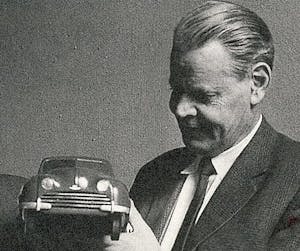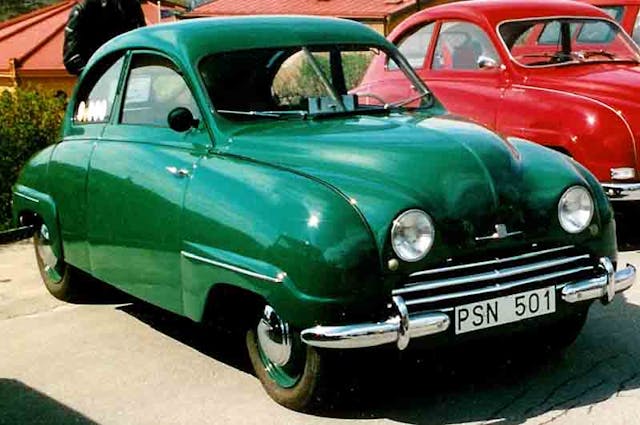Sixten Sason and the little-known, far-reaching legacy of automotive aerodynamics

You likely know the names of Harley Earl, Battista “Pinin” Farina, and Virgil Exner. While each of those men have helped determine the character of a historic brand, it was the lesser-known Sixten Sason who truly popularized the science of aerodynamics in automotive design. Sason didn’t pen his designs for Cadillac or Ferrari or General Motors; he researched, sketched, and tooled for Saab. In many ways, Sason brought aerodynamics to mass market automobiles, beginning with the very first Saab automobile in 1945 (the Ursaab) and continuing with every Saab through the 99, unveiled in 1968. Though Sason died before the 99 was introduced, his design ethos significantly influenced the later 900 models and, through them, just about every car Saab produced.
Cheating the wind
Sason wasn’t the first car designer who tried to cheat the wind. Thanks to his work with wind tunnels, Swiss-based pioneering aerodynamicist Paul Jaray filed for a patent on a teardrop-shaped automobile with a drag coefficient of just 0.29 in 1922. Though Jaray worked for a litany of significant European and American automakers, the small Czech automaker Tatra was the only company to implement Jaray’s work in an actual production automobile.

Tatra is legendary for making cars so fast that Adolph Hitler supposedly banned German officers from driving them after one-too-many high-speed driving accidents. After the end of World War II Tatra was nationalized—even before Communists came to power—and over the next three decades much of Tatra’s relatively limited automobile production was allocated to Party officials and those connected to them.
While many American car designers were likely aware of Tatra and of Jaray’s work, they were more likely to see a Saab on the streets of Detroit or the lanes of Bloomfield Hills than a Tatra 603. The Swedish firm didn’t exactly stampede U.S. shores in 1956, selling only 250 92s in its first year in the American market, but there’s a good chance that the number of stateside Tatras never surpassed that figure in any given year.
From fighter planes to vacuum cleaners

Unlike many car designers, Sason didn’t come from an automotive background. (Neither did Saab, for that matter, who used to proclaim that its cars were “born from jets.” They were, in fact, born from airplanes, but those ancestors wore propellors, not jet engines.) Sixten Sason was born in 1912 to the Andersson family in Skövde, Sweden. His father was an artist, a sculptor who sent him to study art in Paris; Sixten, however, gravitated to industrial design and aviation. A dashing man, Sixten took the surname Sason from the Spanish word for spice, joined the Swedish Air Force, and became a pilot. Unfortunately, a crash ended his aviation career and left him with only one lung.

With his background in art, design, and aviation, it was probably natural that Sason would end up as a freelance designer working for Svenksa Aeroplan AB, better known by the acronym SAAB. When World War II erupted, he worked on the Saab 17 fighter and Saab 18 bomber; by the end of the war, Sason was considered Sweden’s leading industrial designer. His handiwork wasn’t limited to cars, either: Camera maker Hasselblad commissioned him to design a medium-format camera with a reflex viewer, which entered production as the 1600 F, the company’s first civilian-spec model. (Hasselblad would go on to produce the camera used by the Apollo 11 crew in 1969 to capture the first moon landing.) Sason also designed vacuum cleaners for Electrolux and a motorcycle for Swedish conglomerate Husqvarna.

With the war’s end, demand for military aircraft declined. Saab head Ragnar Whargren had already decided to start making cars with efficient shapes and Swedish engineering. Sason was invited to participate in an in-house competition and completed his first sketches in 1946. There is a legend that, uninvited, Sason waltzed into Gunner Ljungström’s office with a bundle of drawings under his arm. (Ljungström was the engineer tasked by Whargren with the design of the first Saab.) Whether or not event matched the legend’s choreography is uncertain, but Sason undoubtedly was the godfather of the first Saab.
Founder of a breed

The first prototype, known as the Ursaab, was designated X9248. Both that vehicle and the production 92 adhered closely to Sason’s early renderings of a bull-nosed, front-wheel-drive car whose body tapered to the back, like Jaray’s teardrop. The unibody reflected Sason’s background in aircraft design, with components hung on a load-bearing central structure and wheels faired into the body, just like “spats” on aircraft tires. The suspension used torsion bars rather than coil springs, perhaps for packaging efficiency. Using a front-wheel-drive platform allowed Sason to lower aerodynamic drag by tapering the rear of the car and helped produce a final figure of 0.30 Cd.
The 92 was powered by a transversely mounted, water-cooled, two-stroke twin with a displacement of just 764 cc. The 25-hp engine was based on a DKW design and could chug the 92 to a a top speed of 65 mph. The transmission was a three-speed affair with a column-mounted shifter. Early Saabs, like some Studebakers, also had a freewheel device. In Studebaker’s case, that was for fuel efficiency; at Saab, it was to protect the two-cycle engine from oil starvation during engine braking. Unlike modern two-stroke motorcycle engines, which have oil injection, early Saabs required the driver to add oil to the gasoline, just as you might do for a chain saw or weed whacker—it wasn’t wise to run them under load with closed throttles.
The Saab 96, essentially an updated 92, used a three-cylinder two-stroke engine. That powerplant was later upgraded to Ford’s four-stroke V-4, sourced from its Taunus commercial vehicles. Only when the 96 switched to the V-4 could Saab owners stop adding oil to the gas tank with each fill-up.

Those early Saabs were exceptionally robust. Between their sturdy build quality, front-wheel-drive construction, and talented rally driver Erik Carlsson, they found considerable success in international rallying, helping to establish Saab as a rugged Swedish competitor to Volvo. The fact that Saabs were universally characterized as “quirky” and Volvos were mechanically and cosmetically staid helped distinguish Saab from its domestic competitor. All Swedish cars were considered safe, but Saabs were imagined as cars for non-conformists—or for people who considered themselves to be so. You’d see plenty of Saabs in college towns.

Sason started work on a successor to the 96 in 1964. The 99 was larger and boasted a modern powerplant and up-to-date passenger protection, though it retained front-wheel drive and other unique Saab features, like an ignition switch mounted between the front seats. The car went into production in 1967, but Sason did not live to see it. He died six months before the 99 was introduced at the age of 54.

Horsepower isn’t everything
As might be expected of an eclectic designer whose work ran the gamut from fighter planes to vacuum cleaners, Sixten Sason’s automotive work was not restricted to sedans (or even to the Saab 95 station wagon). In 1955, a number of Saab engineers lead by Rolf Mellde, a racing enthusiast, developed a two-seat roadster in a barn outside of Trollhattan. They named it Sonett—not as an ode to Shakespeare, but as an allusion to the Swedish saying Så nätt den är (“It’s so neat”). Sixten Sason contributed the aluminum box-style chassis, which weighed just 150 pounds, and the flowing fiberglass body. Though the Sonett generated only 57.5 hp, its light weight and exceptional aerodynamics gave it a top speed of 120 mph. Saab hoped to race the Sonett and planned a production run of 2000 cars for the 1957 model year. However, altered racing rules diminished the Sonett’s chances of success and the project was scrapped after just six (some sources say 16) were built.

A lasting legacy
At a time when gasoline was cheap and natural resources seemed endless, Sixten Sason created a design language based on efficiency. When sitting next to something like a 1956 Chevy, or even a 1972 Ford, his Saabs have always looked a little bit odd—some might consider them ugly ducklings. After the oil embargoes of 1973 and 1979, though, the auto industry started applying aerodynamic principles to all vehicles, not just to performance cars. Today, just about every motor vehicle made, from the simplest economy car to massive 18-wheel tractor-trailers, wears sheetmetal shaped by the aerodynamic principles Sixten Sason helped make ubiquitous.


